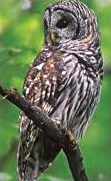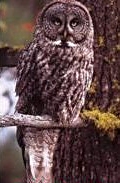The Owls (Strigiformes) is divided into two families: "Barn Owls" (Tytonidae) and
"Typical Owls" (Strigidae). In the family of "Barn Owls" there are 11 species
worldwide and 1 in North America, the "Common Barn-Owl" (Tyto alba). In the family
of "Typical Owls" there are 135 species worldwide and 19 breeding species in
North America. These birds of prey are primarily nocturnal raptors, with deeply
hooked bills and sharp talons. |
LONG- EARED OWL- Asio otus - SIZE (34 - 37 cm) True to its name, the long-Eared owl is crowned with prominent ear tufts. But, like similar adornments on many other owls, the tufts are simply feathers. They have nothing to do with hearing.As with most, the owls' ear openings are hidden beneath feathers on the sides of the head. Proportionally larger than on other birds, in some species they also are asymmetrical---in shape, in size, and in position. Plumage is brown and buff, with heavy mottling and barring over most of the body. Male plumage tends to be lighter than females. The eyes are golden yellow, encircled by black feathers that are set in an orange-brown facial disk. The bill is black. The forehead and lores are mottled grey and white and there is a white chin patch. The legs and feet are heavily feathered. VOICE: A soft, "Hoo, hoo, hoo...," varying in number and given at two-to three second intervals,repeated 10 to 200 times. BREEDING:Nesting occurs mainly from mid March through May in North America. Long-Eared Owls nest almost exclusively in old stick nests of crows, magpies, ravens, hawks, or herons.Clutch sizes range from 3 to 8 eggs.The incubation period is 25 to 30 days. Young become independent from parents at about 2 months. LOCATION:Long-Eared Owls are widely distributed in North America, Eurasia and Northern Africa. HABITATE:Long-Eared Owls inhabit open woodlands, forest edges, riparian strips along rivers, hedgerows, juniper thickets, woodlots, and wooded ravines and gulleys. During winter, roosting sites are usually in the heaviest forest cover available. They will also roost in hedgerows, or in caves and cracks in rock canyons. HUNTING: Long-Eared Owls hunt mainly from late dusk to just before dawn and feed primarily on mammals such as voles and deer mice most common, squirrels, bats, chipmunks, gophers, shrews, moles, and cottontail rabbits.Also birds which includes meadowlarks, blackbirds, juncos, Horned Larks, doves, bluebirds, and thrashers. Larger birds such as grouse and Screech-Owls are occasionally taken. Long-Eared Owls sometimes eat insects, frogs, and snakes. |

SHORT-EARED OWL- Asio flammeus - SIZE (33 - 43 cm) The Short-Eared Owl is a medium-sized nocturnal owl.The plumage is buffy brown with dark streaks on the chest, belly, and back. The wings and tail are strongly barred. The yellow eyes are circled with black and set in whitish or buffy-white facial disks, which are suffused with a ring of brown. The bill is black. The head appears round without ear tufts, but at very close range small ear tufts are visible. In flight, the dark "wrist" on the underwing is the key field mark,coupled with mothlike flight. VOICE:Short-Eared Owls are generally quiet with a territorial song of "voo-hoo-hoo", sound.Both sexes squawk, bark, hiss and squeal when excited. BREEDING:The Short-Eared Owl nests on the ground, unlike most other owls in shelter of a grass mound, under a grass tuft, or among herbaceous ground cover.Lay an average 5 to 7 eggs but can lay up to 14 eggs.Young fledge at about 4 weeks.The Short-Eared Owl may raise 2 broods in 1 year. LOCATION:Short-eared Owls occur worldwide and in most parts of Northern America where suited for food and breeding.Winters in some areas of southern Canada south to Baja California, the Gulf Coast, and southern Florida. HABITATE:Inhabit wide open spaces such as grasslands, prairie, agricultural fields, salt marshes, estuaries, mountain meadows, and alpine and Arctic tundra.Roost in trees only when snow covers the ground. HUNTING:Meadow voles their main diet,also other mammals such as deer mice, shrews, squirrels, gophers, field mice, moles, rats, bats, rabbits, and muskrats.Also small birds inland mainly Horned Larks, meadowlarks, blackbirds, and pipits. Coastal areas where they can target shorebirds, terns, and small gulls and seabirds.Some insects, roaches, grasshoppers, beetles, katydids, and caterpillars are also taken. Short-eared Owls hunt mainly at night and during the morning and late afternoon. |
BARRED-OWL- Strix Varia - SIZE (40 - 63 cm) The Barred Owl includes all sorts of squeaks and squawks, screeches, barks, and yowls. Launching into a maniacal mixture of cries, it can produce a chorus that is truly spine-tingling---especially when heard late at night in the deep, swampy forests that are among its preferred haunts. Small wonder that the bird is known locally in some areas as the crazy owl. A medium-sized grey-brown Owl,round-headed with a whitish-brown facial disk with dark brown trim. Yellow beak nearly covered with feathers and eyes brown.A short bib across neck and upper chest, marked with horizontal brown barring.Belly vertically streaked with dark brown on white. Dorsally, mottled brown and white,and long tail. VOICE:Who-cooks-for-you, who-cooks-for-you-all? is the usual transcription for the most commonly heard call of the barred owl. A far cry from the simple hoot we tend to think of as the typical owl's call, it is a reminder that owls as a group are capable of a varied range of vocalizations.Other calls include "hoo-hoo, hoo-WAAAHH" and "hoo-WAAAHHH" used in courtship. BREEDING:Usual breeding time from March to August.Barred Owls nest in cavities and will also use abandoned nests.Lays 2-4 white round eggs.Incubation period 28-33 days. The young fledge at 35 to 40 days and parents care for them for 4 months. Pairs mate for life and maintaine their nest for many years. LOCATION:Widespread in North America, and occur across most of the eastern half of the continent from Florida northward to southern Canada; they are also spreading westward in the north of their range. HABITATE:Barred Owls prefer deep moist forests, wooded swamps, and woodlands near waterways. HUNTING:Main prey voles and deer mice.Other small mammals include rats, squirrels, young rabbits, bats, moles, opossums, mink, and weasels. Birds are taken occasionally, including,quail, jays, blackbirds, and pigeons. also small fish, frogs, snakes, lizards and insects. |
GREAT-GRAY OWL - Strix Nebulosa - (SIZE(61-84 cm) The Great-Gray Owl is considered to be North America's largest owl and flies short distances from branch to branch and seldom glides.Flies close to the ground, usually less than 6 metres up, except when flying to a nest.The Great Gray Owl is dark grey overall interspersed with bars and flecks of light grey and white. Bulky in appearence because of their fluffy plumage.Wingspan up to 152cm.,and long tail.Large round head and facial disk and small yellow eyes.White noticeable moustache under facial disk and black bill.Feet hidden by feathers. VOICE:The Great-Gray Owl has a loud low and descending, "Whooooo, woo, woo, wo...," that faces.When threatened, a Great Gray Owl will snap its bill,spread its wings, and growl,shriek,hoot,wail. BREEDING::The Great-Gray Owl breed about mid winter.Nest in tall trees,usually abandoned nest made by crows,ravens and hawks.Nest are made of sticks and lined with moss and shredded bark.2to5 eggs are laid,each seperated by 1-2days.Female does the whole incubation and male provides food for female and young.The young fledge about 8weeks and stay with female for several months. LOCATION:Are found in Alaska,Canada,Northern rocky Mountains and Minnesota, also Northern Europe. HABITATE:Dense forest,swampy open areas,forest clearings with few tree,mountain meadows and farm fields. HUNTING:Most important diet are voles and small rodents.Also other small mammals, includes gophers,rats,mice,squirrels,rabbits,shrews,moles. Birds such as ducks, grouse,small hawks and crows.Also frogs,snakes and insects. |
HOME |






| World Owls | African Owls | Australian Owls | European Owls |